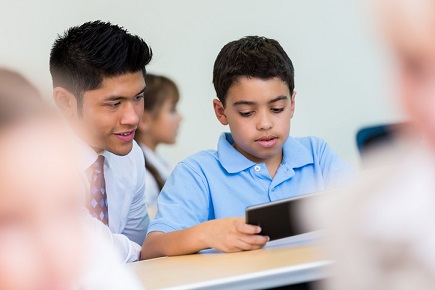
From immersive Virtual Reality (VR) to cloud-based education, schools are increasingly deploying high-tech resources to assist teaching and learning – but amid this digital revolution, is the importance of soft skills being overlooked?
Soft skills are most commonly defined as the ability to think critically, collaborate, problem-solve and interact effectively and harmoniously with other people.
Lisa Kirkland, principal of Harrington Public School, located in NSW, cited Dr Phil Lambert, former general manager of the Australian Curriculum at ACARA, who said a strong focus by schools on ‘soft skills’ is key to preparing students for the future.
“Dr Lambert said that with the rapid development of technologies, schools need to be focusing on the dispositions and accountabilities of their students so they can move into the workforce regardless of the ‘hard skills’ required,” Kirkland told The Educator.
“If we go with the EU’s outline and explorations of what these accountabilities would be, we require education to support problem solving, high level communication, social skills, resilience, digital literacy, social awareness, respectful relationships and self-efficacy.”
Kirkland said her school pursues these by supporting and developing student agency across all areas of learning, staff mapping and designing lessons that not only meet syllabus requirement but support a broader exposure to the world students live in.
“We all need to understand that our world is moving rapidly and is now more defined as the ‘Age of the Knowledge Economy’ more than an Information Economy,” she said.
Kirkland said that because of this, improving 21st Century skills for students is “not only important but imperative”.
“At no other time in recent educational settings have the changes external to school moved so rapidly,” Kirkland said.
“As many renowned researchers, such as Dr Ken Robinson, Steve Dinham, John Hattie and Carol Dweck, have highlighted, if schools don’t move out of their pre-industrial mode, our students will be lacking in the accountabilities they need to function in their economies.”
Kirkland sees the role of the principal and schools to be “the advocates of change” that most departments across Australia are now promoting through policy, system and curricula.
“At times, this means taking risks and allowing their staff to design the lessons that engage our students and develop them in the ways they need to be,” she said.
“There are many ways to do this whilst still meeting all the curriculum and syllabus expectations.”
Kirkland said that while staff should be supported to change and try things they may not be comfortable with, strong instructional leadership is the best way to guide them through this process.
“Leaders need to see that using technology in schools shouldn’t be about the technology replacing an old behaviour or mindset; such as apps become worksheets, websites become textbooks,” she said.
“This is okay, but it shouldn’t be the basis for working technologically. It needs to be about how to develop the technologies, utilise coding, explore the development of coding sequences to problem solve and create.”


